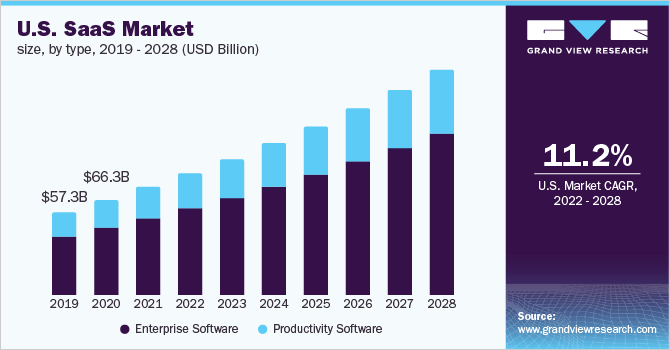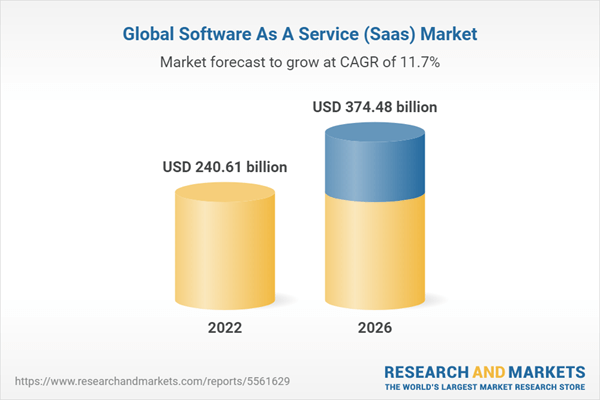- SaaS Market Analysis and Predictions
- SaaS mobile app development
- So, what`s the difference between a Software as a Service application and a stand-alone app?
- SaaS Pros and Cons
- SaaS Pros
- Customer benefits:
- Vendor benefits:
- SaaS Cons
- So, Why to Make an App for SaaS Business
- As a bonus, there are also a few tips for you to take away:
Software as a service (SaaS) is a model of software distribution. The distinctive feature of this pattern is that users rent the software on a monthly cost-per-user or usage basis instead of buying and implementing it. Also, users can scale up and down the scope of service if needed. The essential characteristics of this model are hosted applications, a price based on subscription, and the sharing between multiple users.
SaaS Market Analysis and Predictions
The “SaaS Market Size, Share & Trends Analysis Report” by Grand View Research claims that the global SaaS market size was valued at USD 165.9 billion in 2021 and is anticipated to expand at a compound annual growth rate (CAGR) of 11.0% from 2022 to 2028.

According to the report by The Business Research Company, the global SaaS market will grow from $212.20 billion in 2021 to $240.61 billion in 2022 at a CAGR of 13.4%. In 2026, the market will get to $374.48 billion at a CAGR of 11.7%.

The better part of the spending will go for modernizing and functional expanding of office applications. Developing SaaS apps with cloud-based technology is going to replace the outdated commercial software.
CLOUD SERVICE MODELS EXPLAINED: PAAS VS. SAAS VS. IAAS VS. DBAAS
SaaS mobile app development
Software as a Service is used not only for desktop or laptop devices but also on various mobile devices. Sometimes the SaaS app only adds value to the service or can be used as a dashboard to provide reports for stakeholders. However, the SaaS app can also act as a full-fledged independent player as it occurred with LinkedIn or Dropbox.
So, what`s the difference between a Software as a Service application and a stand-alone app?
- SaaS app doesn’t need any desktop downloads. Users can access the service with direct download from the app store or computer using the secure login.
- The typical monetization model of a SaaS app is a monthly fee that is based on users’ amount, storage capacity, or other features. In stand-alone apps, the cost is determined per person and paid only once. Therefore, the SaaS model in the long term is more beneficial for the vendor in a long run.
- SaaS is perfect for teamwork and allows all members of the group to interact with each other in real-time. Stand-alone apps are not able to ensure users with back and forth communication.
- Mobile SaaS app development is based on cloud technologies. This means that complete information from all team members same as updates is stored in the cloud. With a stand-alone app, you need to export files to Dropbox, email, or another service to share the information.
Judging by the trends, cloud-based SaaS mobile application development became mainstream amongst enterprises. The rise of mobile device usage had an enormous impact on this technology. Just think about the figures. Back in 2010 tablet devices generated $300 million in global app sales. In 2015 that number had raised up to $8.1 billion. John McCarthy, the Forrester Research Vice President had underlined the biggest advantage of SaaS apps in his report “App Internet”. It comes from the ability to work offline. John McCarthy even implemented a new term “offline cloud apps”. However, this is not the only benefit.
SaaS Pros and Cons
Despite SaaS popularity, it comes to many questions and misconceptions when you need to build this sort of application. However, to develop mobile apps for SaaS has become not a trivial question. Your SaaS app development company should take into account the high performance of the app, the ability to be multi-tenancy, reconfigurability, and, most importantly, security issues.
Like any other technology, software as a service deploying has its pros and cons.
SaaS Pros
- Planning the revenue stream
The SaaS monetization model is a monthly subscription. It means that as a vendor you can plan and predict proceeds that are based on the number of your SaaS app users and the number of services you provide. - Scaling the business
As your client`s business grows, you don`t need to worry about scaling yours. The customer can only adjust the monthly subscription according to his needs. No matter how big or small your client`s business, he can always rely on your service because that is way cheaper and easier than to invest in in-house software licenses and server capacities. - Accessibility for customers
All your clients need to set up your SaaS app is a device and internet connection. This simplicity makes SaaS particularly attractive and relieves vendors from unnecessary care. - Upgrades legerity for customers
An additional benefit for your clients is that they have no need to update software and take care of outdated hardware which removes the workload from their IT-departments.
For you as a vendor, the main benefit is that you don`t waste time visiting and updating every customer separately. - Backup resilience
Even if something goes wrong with your servers, your customers can always go back to the previous savings with the backup log and get access to information from any device with an internet connection.
CLOUD SERVICE MODELS EXPLAINED: PAAS VS. SAAS VS. IAAS VS. DBAAS
As you have noticed, SaaS has benefits both for vendors and customers. Check the table below to make out the differences:
Customer benefits:
- Reduce time for deployment;
- Lower risks;
- Quicker access to latest features;
- Absence of ongoing maintenance;
- Low variable cost based on usage instead of upfront fixed cost.
Vendor benefits:
- Revenue stream can be planтed and predicted;
- Software usage can be tracked by the customer;
- Need for maintaining a single code base;
- Scaling helps to capture cost savings.
Want to Learn More About The APP Solutions Approaches In Project Development?
Download Free EbookSaaS Cons
Of course, like any other technology, SaaS has its pitfalls that are not critical though and could be easily fixed.
- Security
Safety is always a number-one concern for any business, startup, or private user. As a service provider, you need to protect sensitive client`s data. At The App Solutions, engineers ensure customers with multiple methods to protect a SaaS app. - Outages
Outages do happen with any service and technology. We all remember the epic Amazon EC2 outage for instance. The primary care of your engineers is to prevent them as thoroughly as possible. Of course, you need to think about technology and communication strategies in case of outages. Then even when an accident happens, you and your team will eliminate it with minimum customers and reputational loss. - Governmental agreement compliance
Well, this, not a con, rather a warning. Help your client to investigate the legislation and determine the regulations that apply to their business.
So, Why to Make an App for SaaS Business
You may think “Ok, I provide my SaaS model through the web platform, why do I need an app for that.” But don`t rush to make a final decision. Even if you have a responsive website, it doesn`t replace an app. As we said at the beginning of the article, the number of mobile devices rapidly extends, and the world itself is becoming more mobile. By providing your customers with an app you give them access to your service at any time, anywhere all over the world. Isn`t it what you’d want as well? To be with your customer 24/7 and become an integral part of his business.
Your native app saves clients time to open the browser and navigate to the tasks. Instead of this, you can give them a custom app that meets the standards of their smartphones with UI/UX design and fast app performance.
Also, an app provides priceless mobile-centric involvement for the most loyal customers and spurs new feature purchases to extend the experience.
WHAT IS MVP IN SOFTWARE DEVELOPMENT?
As a bonus, there are also a few tips for you to take away:
- Don`t forget about the legal agreements for your SaaS app. For sure, the arrangement set depends on the service specifics, but there are some more standard ones that can be used almost in all of them: the privacy policy agreement, the terms, and conditions contract, etc.
- To reduce your SaaS app development cost and make it easy for other applications and services they have on their smartphones, you can use sets of API`s that every SaaS app needs: authorization and authentication API, user management API, usage metrics collection API, operational data storage.
- Stick to the native app development to provide better security, faster performance, and provide access to all inbuilt capabilities of the device.
Want to receive reading suggestions once a month?
Subscribe to our newsletters